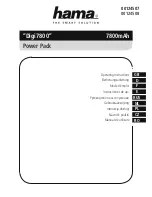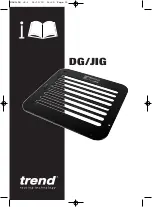
6
7
SAVE THESE INSTRUCTIONS
1)
General power tool safety warnings-Work area safety
• Keep work area clean and well lit.
Cluttered or dark areas invite accidents.
• Do not operate power tools in explosive atmospheres, such as in the presence of
flammable liquids, gases or dust.
Power tools create sparks which may ignite the dust or
fumes.
• Keep children and bystanders away while operating a power tool.
Distractions can cause
you to lose control.
2)
General power tool safety warnings- Electrical safety
• Power tool plugs must match the outlet. Never modify the plug in any way.
Do not use
any adapter plugs with earthed (grounded) power tools. Unmodified plugs and matching
outlets will reduce risk of electric shock.
• Avoid body contact with earthed or grounded surfaces, such as pipes, radiators, ranges
and refrigerators.
There is an increased risk of electric shock if your body is earthed or
grounded.
• Do not expose power tools to rain or wet conditions.
Water entering a power tool will
increase the risk of electric shock.
• Do not abuse the cord. Never use the cord for carrying, pulling or unplugging the power
tool. Keep cord away from heat, oil, sharp edges or moving parts.
Damaged or
entangled cords increase the risk of electric shock.
• When operating a power tool outdoors, use an extension cord suitable for outdoor use.
Use of a cord suitable for outdoor use reduces the risk of electric shock.
• If operating a power tool in a damp location is unavoidable, use a residual current
device (RCD) protected supply.
Use of an RCD reduces the risk of electric shock.
• Be sure to use electrical supplies that are suitable for the conditions.
If working
outdoors, use extension cords rated for outdoor use (marked "W-A" or HWn) - this
reduces the risk of electrical shock.
• If you have to work in a damp location, be sure to use a ground fault circuit interrupter
(GFCI) protected supply.
This will help reduce the risk of electrical shock.
3)
General power tool safety warnings- Battery tool use and care
• Recharge only with the charger specified by the manufacturer.
A charger that is suitable
for one type of battery pack may create a risk of fire when used with another battery
pack.
• Use power tools only with specifically designated battery packs.
Use of any other
battery packs may create a risk of injury and fire.
• When battery pack is not in use, keep it away from other metal objects, like paper clips,
coins, keys, nails, screws or other small metal objects, that can make a connection from
one terminal to another.
Shorting the battery terminals together may cause burns or a
fire.
• Under abusive conditions, liquid may be ejected from the battery; avoid contact. If
contact accidentally occurs, flush with water. If liquid contacts eyes, additionally seek
medical help.
Liquid ejected from the battery may cause irritation or burns.
• Do not use a battery pack or tool that is damaged or modified.
Damaged or modified
batteries may exhibit unpredictable behaviour resulting in fire, explosion or risk of injury.
• Do not expose a battery pack or tool to fire or excessive temperature.
Exposure to fire
or temperature above 130 °C may cause explosion.
NOTE The temperature “130 °C” can be replaced by the temperature “265 °F”.
• Follow all charging instructions and do not charge the battery pack or tool outside the
temperature range specified in the instructions.
Charging improperly or at temperatures
outside the specified range may damage the battery and increase the risk of fire.
5)
General power tool safety warnings- Personal safety
• Stay alert, watch what you are doing and use common sense when operating a power
tool.
Do not use a power tool while you are tired or under the influence of drugs, alcohol or
medication. A moment of inattention while operating power tools may result in serious
personal injury.
• Use personal protective equipment. Always wear eye protection.
Protective equipment
such as a dust mask, non-skid safety shoes, hard hat or hearing protection used for
appropriate conditions will reduce personal injuries.
to power source and/or battery pack, picking up or carrying the tool.
Carrying power
tools with your finger on the switch or energising power tools that have the switch on
invites accidents.
• Remove any adjusting key or wrench before turning the power tool on.
A wrench or a key
left attached to a rotating part of the power tool may result in personal injury.
• Do not overreach. Keep proper footing and balance at all times.
This enables better
control of the power tool in unexpected situations.
• Dress properly. Do not wear loose clothing or jewellery.
Keep your hair and clothing away
from moving parts. Loose clothes, jewellery or long hair can be caught in moving parts.
• If devices are provided for the connection of dust extraction and collection facilities,
ensure these are connected and properly used.
Use of dust collection can reduce
dust-related hazards.
• Do not let familiarity gained from frequent use of tools allow you to become complacent
and ignore tool safety principles.
A careless action can cause severe injury within a
fraction of a second.
• Be sure to properly connect and use any devices that extract and collect dust.
When
used properly, dust collection can reduce situations related to dust and debris hazards.
• Do not run the cordless Oscillating tool while carrying it at your side.
A spinning socket or
bit could become entangled with clothing and injury may result.
• Disconnect the plug or remove the battery pack from tool and place the switch in the
locked or "OFF" position before making any assembly adjustments, changing
accessories, performing any inspection, maintenance or cleaning procedures.
Such
preventive safety measures reduce the risk of starting the tool accidentally.
• Do not use the cordless Oscillating tool if it has been damaged, left outdoors in the rain,
snow, wet or damp environments, or immersed in liquid.
5)
General power tool safety warnings- Power tool use and care
• Do not force the power tool. Use the correct power tool for your application.
The correct
power tool will do the job better and safer at the rate for which it was designed.
Any power tool that
cannot be controlled with the switch is dangerous and must be repaired.
• Disconnect the plug from the power source and/or remove the battery pack, if detachable,
from the power tool before making any adjustments, changing accessories, or storing
power tools.
Such preventive safety measures reduce the risk of starting the power tool
accidentally.
• Store idle power tools out of the reach of children and do not allow persons unfamiliar with
the power tool or these instructions to operate the power tool.
Power tools are dangerous
in the hands of untrained users.
• Maintain power tools and accessories.
Check for misalignment or binding of moving parts,
damaged, have the power tool repaired before use. Many accidents are caused by poorly
maintained power tools.
• Keep cutting tools sharp and clean.
Properly maintained cutting tools with sharp cutting
edges are less likely to bind and are easier to control.
• Use the power tool, accessories and tool bits etc. in accordance with these instructions,
taking into account the working conditions and the work to be performed.
Use of the
20V ULTRA Oscillating Multi-Tool 2Ah KIT
(MH-03-OT-B1-0-1)
20V ULTRA Oscillating Multi-Tool 2Ah KIT
(MH-03-OT-B1-0-1)





































